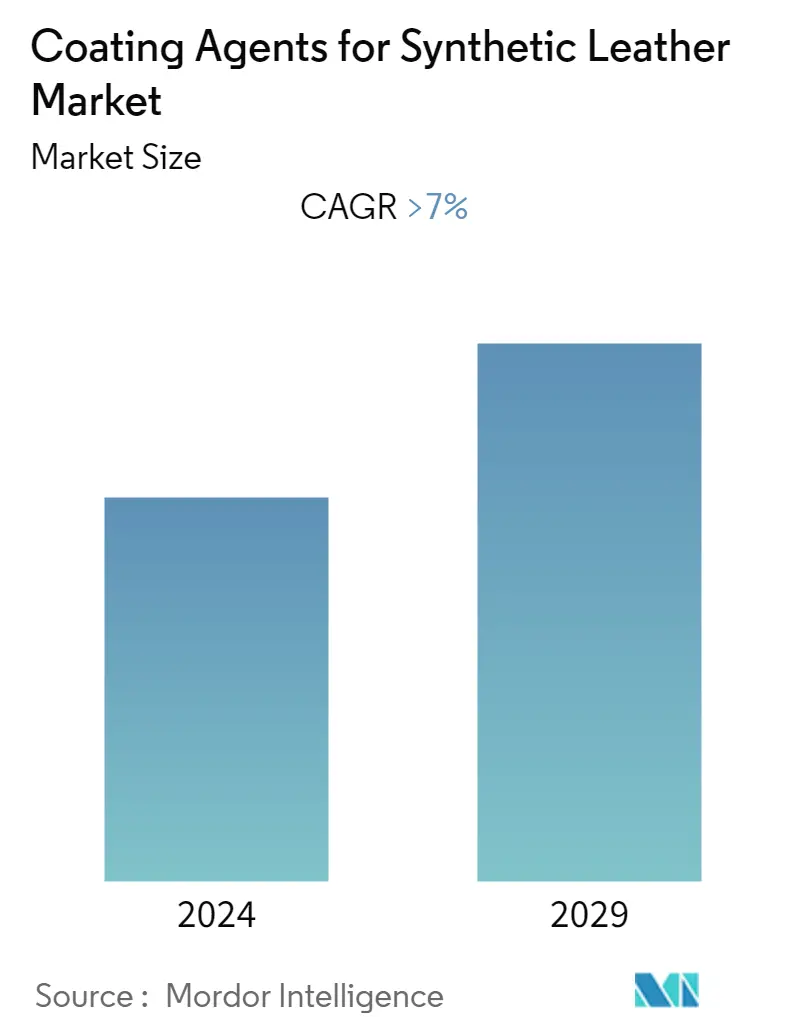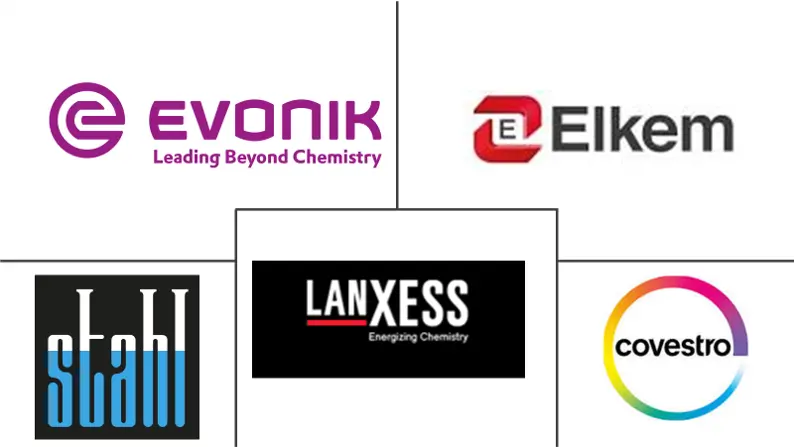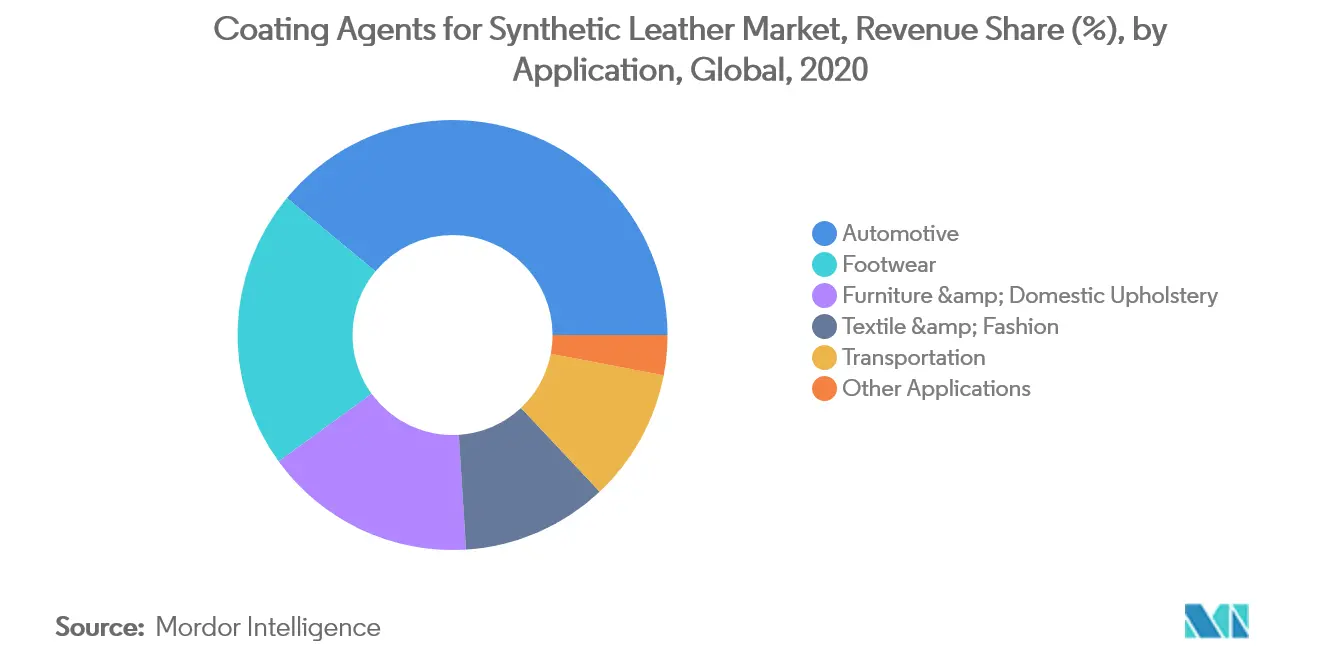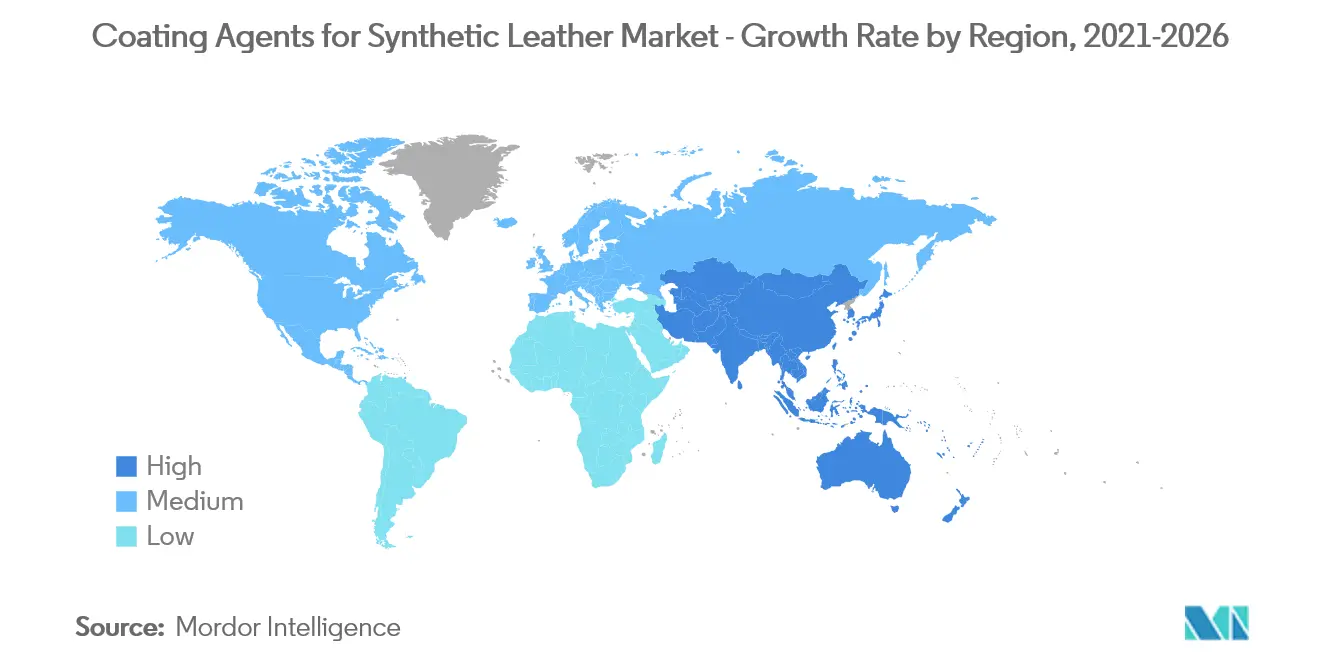Coating Agents for Synthetic Leather Market Size

| Study Period | 2019 - 2029 |
| Base Year For Estimation | 2023 |
| CAGR | 7.00 % |
| Fastest Growing Market | Asia Pacific |
| Largest Market | Asia Pacific |
| Market Concentration | Low |
Major Players
*Disclaimer: Major Players sorted in no particular order |
Coating Agents for Synthetic Leather Market Analysis
The global coating agents for synthetic leather market was valued at over USD 500 million in 2020, and the market is projected to register a CAGR of over 7% during the forecast period (2021-2026).
The market was negatively impacted by COVID-19 in 2020. Amid the global COVID-19 situation, the footwear industry generated a revenue of USD 432.11 billion in 2020 compared to USD 439.02 billion in 2019. According to the OICA, the global production of automobiles was 77,621,582 in 2020, a decline of 16% compared to 2019, impacting the demand for coating agents in synthetic leather. Similarly, other industries, including textile and fashion, furniture, etc., were also impacted adversely by COVID-19, which had a negative impact on the market studied. However, the market situation is expected to recover in 2021 as lockdown has been lifted in several countries worldwide.
- Over the short term, a major factor driving the growth of the market studied is PETA regulations limiting the usage of natural leather.
- By application, the automotive industry dominates the market during the forecast timeline.
- Asia-Pacific is expected to dominate the market and witness the highest CAGR during the forecast period.
Coating Agents for Synthetic Leather Market Trends
This section covers the major market trends shaping the Coating Agents For Synthetic Leather Market according to our research experts:
Automotive Industry to Dominate the Market
- The use of coating agents in synthetic leather results in a lightweight and highly durable material while providing superior hydrolysis resistance, moisture heat resistance, and chemical resistance. It is used in various interior automotive applications, such as steering, wheels, and seats.
- The use of synthetic leather makes car seats more comfortable, and its highly abrasion-resistant property helps manufacturers meet the stringent volatile organic compound (VOC) standards for applications such as car seats and furniture.
- The BASF synthetic leather product portfolio includes Haptex, a polyurethane (PU) system solution for the production of synthetic leather.
- Suzhou Ruigao New Material Co. Ltd, a leading manufacturer of synthetic leather, adopted the product of BASF SE, Elastollan-grade B50A12CF made of thermoplastic polyurethane, in the production of synthetic leather in a Chinese automaker's latest model due to its cost-effective and environment-friendly thermoplastic process in comparison with conventional processing technologies such as coagulation.
- However, the recent decline in the automotive industry had a negative effect on the market. The automobile industry witnessed a rapid decline in 2019 after experiencing continuous growth for 10 years. According to the OICA, the automobile industry registered a negative growth of 5% in 2019, and the production declined from 95.63 million units produced in 2018 to only 91.78 million units in 2019.
- After a bleak 2019, where the global automotive sales decreased by 6%, the world automotive production faced a new and unprecedented challenge during 2020. In 2020, the COVID-19 pandemic impacted the automobile sector, with lockdowns implemented across all countries, which resulted in an automotive production halt.
- In 2020, the production of automotive saw a decline of 16%, reaching 77.62 million units compared to 91.79 million units in 2019. However, it is expected to take few quarters for the industry to reach at least the pre-COVID levels of automotive consumption. At the same time, the production follows with a delay, owing to accumulated inventories.
- The industry is also facing crash crunch issues. These factors are likely to have an adverse impact on the demand for the market studied in the early part of the forecast period. However, synthetic leather is expected to replace traditional leathers used in vehicle seats and other interior components of the vehicle over the coming years.
- Such a scenario will push the demand for coating agents from the studied market in the forecasted period.

Asia-Pacific to Dominate the Market
- Asia-Pacific held the highest market share, accounting for more than 50% of the market. China is the largest synthetic leather market in Asia-Pacific, owing to robust growth in the automotive and footwear end-user industries in the country.
- China is the largest automotive market in the world. The automotive industry in China is mainly driven by domestic market demand. According to OICA, the country produced 25,225,242 vehicles in 2020, a decline of 2% compared to 2019. the production of automobiles is expected to increase owing to the rising demand for electric vehicles positively impact the demand for coating agents for synthetic leather for seat covers, steering, and other interior applications.
- The footwear industry in Japan witnessed revenue of USD 27.93 billion in 2020 and is expected to grow by 2.57% to reach USD 32.13 billion by the end of 2025 revenue, positively impacting the market demand.
- The athletic footwear end-user segment witnessed steady growth over the past five years, changing fashion trends, and shifting consumer preferences toward popular brands.
- According to Invest India, Ministry of Commerce and Industry, India, the textile industry in the country contributes 12% in the export earnings of the country, which was USD 14 billion in 2020, and it is expected to grow by 7.6% to reach USD 23.3 billion by 2027.
- Therefore, considering the aforementioned factors, the demand for coating agents in synthetic leather is expected to increase significantly in the region during the forecast period.

Coating Agents for Synthetic Leather Industry Overview
The global coating agents for synthetic leather market is highly fragmented in nature. Some of the major players in the market include Stahl Holdings BV, LANXESS, Evonik Industries AG, Covestro AG, and Elkem ASA.
Coating Agents for Synthetic Leather Market Leaders
-
Stahl Holdings B.V.
-
LANXESS
-
Evonik Industries AG
-
Covestro AG
-
Elkem ASA
*Disclaimer: Major Players sorted in no particular order

Coating Agents for Synthetic Leather Market News
- In March 2021, Stahl Holdings BV introduced Stahlite systems based on specialty polymers to produce lightweight automotive leathers. The use of Stahlite reduces the weight of synthetic leather up to 30% compared to traditional leather material.
Coating Agents for Synthetic Leather Market Report - Table of Contents
1. INTRODUCTION
- 1.1 Study Assumptions
- 1.2 Scope of the Study
2. RESEARCH METHODOLOGY
3. EXECUTIVE SUMMARY
4. MARKET DYNAMICS
-
4.1 Drivers
- 4.1.1 PETA Regulations limits Usage of Natural Leather
- 4.1.2 Other Drivers
-
4.2 Restraints
- 4.2.1 Impact of COVID-19
- 4.3 Industry Value-Chain Analysis
-
4.4 Porter's Five Forces Analysis
- 4.4.1 Bargaining Power of Suppliers
- 4.4.2 Bargaining Power of Consumers
- 4.4.3 Threat of New Entrants
- 4.4.4 Threat of Substitute Products and Services
- 4.4.5 Degree of Competition
5. MARKET SEGMENTATION
-
5.1 Resin Type
- 5.1.1 PU
- 5.1.2 PVC
- 5.1.3 Silicone
- 5.1.4 Other Resin Types
-
5.2 Application
- 5.2.1 Automotive
- 5.2.2 Furniture and Domestic Upholstery
- 5.2.3 Footwear
- 5.2.4 Textile and Fashion
- 5.2.5 Transportation
- 5.2.6 Other Applications
-
5.3 Geography
- 5.3.1 Asia-Pacific
- 5.3.1.1 China
- 5.3.1.2 India
- 5.3.1.3 Japan
- 5.3.1.4 South Korea
- 5.3.1.5 Rest of Asia-Pacific
- 5.3.2 North America
- 5.3.2.1 United States
- 5.3.2.2 Canada
- 5.3.2.3 Mexico
- 5.3.3 Europe
- 5.3.3.1 Germany
- 5.3.3.2 United Kingdom
- 5.3.3.3 Italy
- 5.3.3.4 France
- 5.3.3.5 Rest of Europe
- 5.3.4 South America
- 5.3.4.1 Brazil
- 5.3.4.2 Argentina
- 5.3.4.3 Rest of South America
- 5.3.5 Middle-East and Africa
- 5.3.5.1 Saudi Arabia
- 5.3.5.2 South Africa
- 5.3.5.3 Rest of Middle-East and Africa
6. COMPETITIVE LANDSCAPE
- 6.1 Mergers and Acquisitions, Joint Ventures, Collaborations, and Agreements
- 6.2 Market Share (%)**/Ranking Analysis
- 6.3 Strategies Adopted by Leading Players
-
6.4 Company Profiles
- 6.4.1 Abhilash Chemicals and Pharmaceuticals Pvt Ltd
- 6.4.2 CHT Group
- 6.4.3 Covestro AG
- 6.4.4 Dow
- 6.4.5 Elkem ASA
- 6.4.6 Evonik Industries AG
- 6.4.7 Jasch Industries Limited
- 6.4.8 LANXESS
- 6.4.9 Papertex Speciality Chemicals Pvt Ltd
- 6.4.10 ROWA GROUP Holding GmbH
- 6.4.11 Stahl Holdings BV
- 6.4.12 W. R. Grace & Co.-Conn.
- 6.4.13 Wacker Chemie AG
- *List Not Exhaustive
7. MARKET OPPORTUNITIES AND FUTURE TRENDS
** Subject To AvailablityCoating Agents for Synthetic Leather Industry Segmentation
Coating agents used in synthetic leather result in a lightweight and highly durable material while providing superior hydrolysis resistance, moisture heat resistance, and chemical resistance. The market is segmented on the basis of resin type, application, and geography. By resin type, the market is segmented into PU, PVC, silicone, and other resin types. By application, the market is segmented into automotive, furniture and domestic upholstery, footwear, textile and fashion, transportation, and other applications. The report also covers the market size and forecasts for the coating agents for synthetic leather market in 15 countries across major regions. For each segment, the market sizing and forecast have been done on the basis of revenue (USD million).
| Resin Type | PU | |
| PVC | ||
| Silicone | ||
| Other Resin Types | ||
| Application | Automotive | |
| Furniture and Domestic Upholstery | ||
| Footwear | ||
| Textile and Fashion | ||
| Transportation | ||
| Other Applications | ||
| Geography | Asia-Pacific | China |
| India | ||
| Japan | ||
| South Korea | ||
| Rest of Asia-Pacific | ||
| Geography | North America | United States |
| Canada | ||
| Mexico | ||
| Geography | Europe | Germany |
| United Kingdom | ||
| Italy | ||
| France | ||
| Rest of Europe | ||
| Geography | South America | Brazil |
| Argentina | ||
| Rest of South America | ||
| Geography | Middle-East and Africa | Saudi Arabia |
| South Africa | ||
| Rest of Middle-East and Africa |
Coating Agents for Synthetic Leather Market Research FAQs
What is the current Coating Agents for Synthetic Leather Market size?
The Coating Agents for Synthetic Leather Market is projected to register a CAGR of greater than 7% during the forecast period (2024-2029)
Who are the key players in Coating Agents for Synthetic Leather Market?
Stahl Holdings B.V., LANXESS , Evonik Industries AG, Covestro AG and Elkem ASA are the major companies operating in the Coating Agents for Synthetic Leather Market.
Which is the fastest growing region in Coating Agents for Synthetic Leather Market?
Asia Pacific is estimated to grow at the highest CAGR over the forecast period (2024-2029).
Which region has the biggest share in Coating Agents for Synthetic Leather Market?
In 2024, the Asia Pacific accounts for the largest market share in Coating Agents for Synthetic Leather Market.
What years does this Coating Agents for Synthetic Leather Market cover?
The report covers the Coating Agents for Synthetic Leather Market historical market size for years: 2019, 2020, 2021, 2022 and 2023. The report also forecasts the Coating Agents for Synthetic Leather Market size for years: 2024, 2025, 2026, 2027, 2028 and 2029.
Coating Agents for Synthetic Leather Industry Report
Statistics for the 2024 Coating Agents for Synthetic Leather market share, size and revenue growth rate, created by Mordor Intelligence™ Industry Reports. Coating Agents for Synthetic Leather analysis includes a market forecast outlook to 2029 and historical overview. Get a sample of this industry analysis as a free report PDF download.



